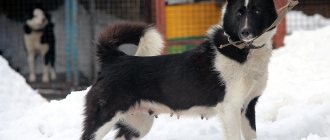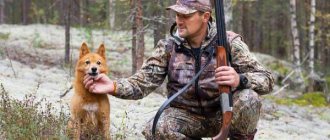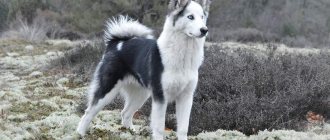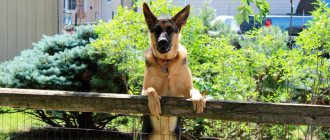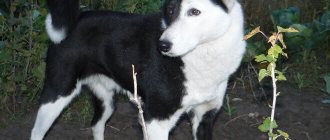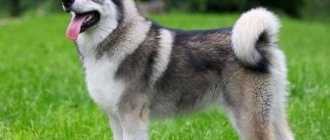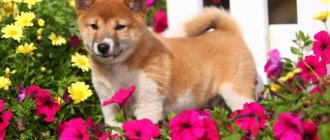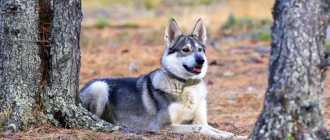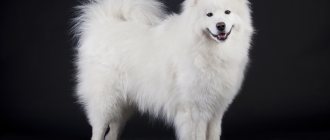History of the breed
Gray Elkhounds appeared many centuries ago. The breed was officially registered when a new variety was developed - the Norwegian Black Elkhound. The event occurred in 1901 and both varieties were recognized.
Since time immemorial, these dogs have been considered the national Norwegian dogs. They were loyal friends, but were still made to help hunt large game such as elk and bear. The extraordinary flair of the northern dog, its endurance and passion for the hunt certainly led to the capture of prey, and the hunter never returned from the hunt empty-handed.
Today, the Norwegian Elkhound is also popular among hunters. With its help, you can track and catch lynx, wolves and a variety of small game. But not only avid hunters buy puppies. This breed is truly a family breed. The Elkhound is kind, obedient, intelligent and affectionate, gets along well with children, allows them to play with him and behaves more than carefully when playing. He will never, even accidentally, bite a child or attack a pet.
Getting to know the breed
Apparently, this is one of the oldest Scandinavian breeds of hunting huskies. The ancestors of the Norwegian Laika have been known since ancient times. For many centuries they lived in harsh conditions and were used not only for hunting, but also as guard dogs. As a result, the Norwegian Laika has long been formed into an independent breed with specific external and behavioral characteristics. At the exhibition, Norwegian elk huskies were first shown in Norway in 1879. Soon this breed was officially recognized by the Norwegian and Swedish kennel clubs.
The Norwegian Elk Husky is a well-built, strong, square dog slightly below average height. The ideal height at the withers for males is 52 cm, for females 49 cm. The color is zoned gray with a faint buffy tint and with black tops of the guard hairs. On the chest, belly, legs, tail and underside of the tail the color is much lighter. Across the body, behind the shoulder blades, there is a well-defined narrow “shawl” - a lightish stripe. The muzzle and ears are dark. The breed standard has strict color requirements. All deviations from the gray color, as well as excessively dark or excessively light gray colors, are not allowed. Yellow and white spots and marks are also not allowed.
The head of the Norwegian Gray Elk Husky is wide at the back, with a slightly rounded forehead. The transition from forehead to muzzle is well expressed, but not sharp. The muzzle is not long, rather wide at the base, evenly tapering towards the end, not pointed. Eyes with a slightly slanted eyelid, brown, the darker the better. A look with an energetic, fearless expression. The ears are pointed, set high, and relatively small. Their height is slightly greater than their width at the base.
The body is short, strong, slightly barrel-shaped, with a slightly tucked belly. The limbs are strong, with slightly oval paws and slightly angulated hocks. There should be no dewclaws. The tail in a tight ring is pressed to the back or to the rump, but not to the thigh. The coat is lush. On the neck and shoulders there is a longer, standing type. The rest of the body is semi-contiguous.
By nature, the Norwegian elk husky is a brave dog, without excessive aggressiveness, a calm, not pugnacious dog, but when attacked, it knows how to stand up for itself and is not intimidated. When communicating with its owner, it shows an amazing combination of independence and affection for the owner. Dogs of this breed are smart and sensitive to both affection and praise, and reproaches. When training them, there is no need to resort to punishment. One of the unusual features of the gray Norwegian elk husky is that it does not have a specific dog odor.
With dogs of this breed you can hunt a variety of game: elk, bear, lynx, small fur-bearing animals and birds. Currently, only moose are hunted with them. Due to their calm nature, these huskies can be used for hunting in pairs and even hunting with several dogs.
The Norwegian Gray Elk is popular in Norway, Sweden and Finland. It is also very famous in a number of other countries, in particular in the USA, where in the 60s it ranked 34th in popularity among 115 registered breeds. It is also bred in England and Canada.
Appearance description
As a rule, the Elkhound is quite large, it grows up to 50 centimeters at the withers, it can weigh from 20 to 25 kilograms, girls are slightly smaller. The dog is proportionally built and has a very similar appearance to the husky, which is why it is also called that. The muzzle is quite cute, without rough features. The head is rounded and has triangular ears that are very movable. The paws are powerful, with fairly wide but neat feet, which allow them to easily overcome snow cover and long distances. The chest is wide, the tail is held in a ring, like all huskies.
Norwegian black elk - appearance and description
Externally, this dog is very similar to a husky, slightly below average size. height at withers 47-49 cm for boys and 44-46 cm for girls. Weight from 17 to 25 kg.
With proper maintenance, life expectancy is 10-14 years
The physique is light, muscular, but not massive. The body proportions are correct. The back is straight, the chest is well developed, the stomach is tucked. The paws are muscular, the bones are not wide, the neck is sinewy, not very long. The head is proportional, light, the jaws are narrow, the bite is correct. The ears are set high and triangular in shape. The eyes are dark brown and intelligent. The tail, like that of all huskies, is curled in a tight ball. The coat is coarse, thick, with a dense undercoat. On the neck, chest and tail of medium length, on the lower part of the paws and on the muzzle there is short hair. The color for this breed of dog is only black, which is not surprising; other colors of this particular breed of Norwegian Elkhound are naturally not allowed.
Personality of the Norwegian Black Elk Husky
The Norwegian Husky has a balanced character. She is very mobile, resilient, and quick in her movements. Playful, loves children. Aggression manifests itself exclusively during hunting and only in relation to prey. In other situations it is a cute and friendly animal. It is not suitable for security service, but it can be used as a watchman: it will give a signal with its ringing bark. The working hunting qualities of the Norwegian Black Elkhound are simply excellent: it is able to find and hold a large ungulate until the owner approaches, or can bring it out under a shot. It works best in a small flock of about three individuals, but a single husky is also good.
Advantages and disadvantages
The Norwegian Black Elkhound is unpretentious, hardy, and an excellent hunter. Has excellent eyesight, smell and hearing. It tolerates sudden climate changes well and tolerates low temperatures well. Suitable for keeping in rural areas, in an enclosure. Living in an apartment is less suitable for him. Does not require special coat care, just brushing once a week with a stiff brush is enough.
Among the disadvantages: it requires large daily loads, that is, you need to walk for several hours every day so that the pet gets physically tired, but not too much. Since this is a rare dog breed in Russia, the cost of a Norwegian husky puppy is very high.
Coat and color
When describing external data, I would like to pay special attention to the quality of the coat and color. The Norwegian Elkhound is a northern dog, and nature has endowed it with coarse hair and a thick silver undercoat that will protect it from any bad weather. The breed's neck is decorated with a luxurious collar.
As we wrote earlier, today there are two known breeds of Norwegian Elkhound - the black moose husky and the gray moose husky. They are similar in temperament, but differ in color, coat and slightly in physical characteristics. The black Elkhound's coat is rougher and shorter, while the gray Elkhound's is softer and longer. Both huskies may have white markings, but they are still not welcome. The black Elkhound is more mobile, active and flexible, the gray one is a little clumsy at first glance, but this is far from the case. He is calmer and more reasonable, carefully considering his every action and movement.
Swedish dog breeds
Sweden is known as the home of the other three Spitz breeds: the Swedish Elkhound, the Norrbotten Husky and the Swedish Lapphund. The Swedish Elkhound (Jamthund) and the Norrbotten Laika were bred for hunting and property guarding. To realize their guard qualities, no additional training or training is required. The Swedish Elkhound is still used for hunting moose, and the Norrbotten Laika is still used for hunting rabbits and squirrels.
The Swedish Lapphund is one of the oldest dog breeds and was originally used to protect and guard deer by the ancient hunting tribes that inhabited Scandinavia during the Neolithic or Stone Age.
Swedish Elkhound
Norrbotten Husky
Swedish Lapphund
Psychological picture
The Norwegian Elkhound is a fairly independent and independent creature. He himself knows the rules of behavior, he thinks about his actions, the conditions of the northern country have taught him to do this. He is very friendly, active, obedient and affectionate. He loves it when his owner praises him and is very kind to all family members. He is intolerant of pets and is unlikely to make friends with them, but still he will not touch or offend them. He will be an excellent companion in children's games. The Norwegian Elkhound loves children very much.
He is wary of strangers, but does not show direct aggression until there is a need to protect his own.
From an early age, the Elkhound needs affection, strict, but careful and kind education. In return, he will give his love, help and protection.
The active northern dog needs constant physical activity, so it is not suitable for lazy people and couch potatoes. With such a friend you need to walk a lot and for a long time. Hiking through the forest or just across a large area is suitable. If you like to ride a bike, feel free to take your dog with you, he will run after you with great pleasure.
The Norwegian dog is the Viking's best friend!
On the very shore of the Arctic Ocean, washed by cold stormy waves, lies the amazing country of Norway. Green in summer and gloomy in long winter, it became the homeland of stern men and determined women.
The northern people, otherwise known as the Vikings, gained fame through military campaigns and warlike offensives. Meanwhile, the Vikings were also excellent traders, farmers, hunters, and craftsmen.
Norway's mountainous, forested terrain is an excellent home for large wild animals. Kings of the forest - moose were the main type of meat in the diet of the ancient Norwegians. This means that hunting moose, the “heroes of the Norwegian tundra,” was a very popular activity in ancient Scandinavia. In modern Norway, moose hunting is still popular. Many hunters visit Norway precisely for these animals and the opportunity to hunt horned giants.
However, the landscape features of the “land of fjords and the midnight sun” allow people to hunt exclusively when accompanied by dogs. It is the dog that has the most difficult job in catching a moose. This means that the dog for catching the Royals of the Norwegian tundra had to be special. And this special dog was the Norwegian Laika Elkhound.
Despite the fact that the breed standard for the Norwegian Laika was developed quite recently (in 1865 - 1877), Elkhounds lived in the territory of ancient Scandinavia for a long time. According to legend, the Norwegian husky helped people not only in hunting, but also accompanied the Vikings on sea voyages.
Thanks to their intelligence, intuition, and excellent sense of smell, Elkhounds have become excellent hunting and working dogs. The Norwegian husky can not only pick up the trail of a moose, being several kilometers away from the animal, but also hold the animal until the owner arrives.
In addition, the Elkhound can also serve as a sled dog. Harnessed to a special sleigh - a sled, they can deliver cargo to its destination. Dogs of this breed are very energetic, which means they can be an excellent companion in active recreation for their owner. Biking, running, skiing and just hiking can all be shared with your furry Norwegian friend.
The abilities of the Norwegian Elkhound are truly multifaceted. These wonderful dogs are not only excellent hunters, but also excellent watchdogs and protectors. Elkhounds also excel at herding duties. In modern Norway, these dogs are increasingly being used to work in nursing homes, orphanages and to help people with disabilities.
Well, as for the appearance of Elkhounds, in their beauty they are in no way inferior to all the famous blue-eyed Siberian Huskies.
If you, like the Norwegians, are captivated by these amazing dogs, then feel free to get yourself this wonderful furry friend from the North. Or just treat yourself to a souvenir with a handsome Norwegian Elkhound, who will soon be participating in the promotion.
Well, in the end I’ll just add: love dogs and they will respond to you with much more love than you could expect from them.
Training
The Norwegian Elkhound should be trained from an early age, because when it grows up, it will turn into an independent dog. To train teams, they need a dominant owner who will strictly, consistently and fairly train and give knowledge about the necessary disciplines and rules of behavior. The elk husky is very smart and quickly learns commands. She will try, just don’t forget to praise her. The Norwegian Elkhound is demanding of praise for its merits, so if it does not receive kind words and encouragement, it will answer you in kind.
Nutrition
If you decide to feed your dog homemade, natural food, you must remember that the dog is a carnivore, and its daily diet should contain at least thirty percent meat. The Norwegian Elkhound is an active breed, it spends a lot of energy, so we increase the amount of meat to fifty percent. The rest of the food is porridge with water made from buckwheat, oatmeal, millet and rice. Sometimes you can give rolled oats. Avoid barley completely, as it is practically indigestible, and peas, because they cause bloating. Boiled and raw vegetables are required for nutrition every day.
Milk should not be given as it can cause diarrhea. Give low-fat cottage cheese, low-fat kefir or yogurt. Under no circumstances should you pamper your dog with buns or other flour products; they will cause your pet to gain a lot of weight. Avoid sweet treats to avoid damaging your teeth; it will be healthier for them to get a tasty bone.
Dry food is perfect, but only premium or super premium; economy food is practically devoid of much-needed meat. If you choose this diet, then do not forget to constantly fill the dog’s bowl with water.
Norwegian Elkhound puppies
The offspring is born completely black, but over time it becomes lighter, having shed several times (of course, if it is not a black Elkhound). As puppies they are very plush and cute. A good puppy costs about 65,000 rubles.
If you are purchasing such a dog, contact an experienced breeder. The enclosures where dogs are kept should be dry and there should be no unpleasant odor. When choosing a pet, be guided by the fact that the puppy is active and mobile, makes contact, and plays with his brothers.
An experienced breeder will suggest the best “baby” from the entire litter. He will explain how to properly maintain and raise, feed and train. Usually the breeder offers assistance in training at first. If you have the opportunity, do not refuse such services.

